This is the 2nd installment of the "Getting Started" series, and the audience is the user who is new to the SG Procedures. It is quite possible that an experienced users may also find some useful nuggets here.
One of the most popular and useful graph types is the Bar Chart. The SGPLOT procedure supports many types of bar charts, each suitable for some specific use case. Today, we will discuss the most common type, the venerable VBAR statement. In this article I will show you many small examples of bar charts with increasing information.
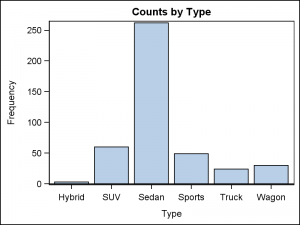 Let us start with the most basic case, as shown on the right. This graph shows the frequency or counts by category with default settings. Click on the graph for a higher resolution image. The SGPLOT code needed to create is very simple, as shown below.
Let us start with the most basic case, as shown on the right. This graph shows the frequency or counts by category with default settings. Click on the graph for a higher resolution image. The SGPLOT code needed to create is very simple, as shown below.
title 'Counts by Type';
proc sgplot data=sashelp.cars;
vbar type;
run;
The graph above is rendered to the LISTING destination with default style and default setting for the axes.
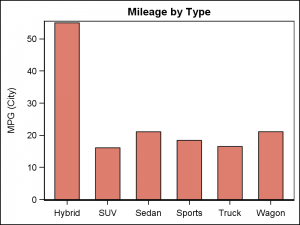 The graph on the right shows the mean of city mileage by type. The title already mentions "Mileage by Type", so there is no need to repeat that information as the label of the x-axis. The label is suppressed by the x-axis option.
The graph on the right shows the mean of city mileage by type. The title already mentions "Mileage by Type", so there is no need to repeat that information as the label of the x-axis. The label is suppressed by the x-axis option.
title 'Mileage by Type';
proc sgplot data=sashelp.cars;
vbar type / response=mpg_city stat=mean
barwidth=0.6 fillattrs=graphdata2;
xaxis display=(nolabel);
run;
Note, we have specified RESPONSE=mpg_city, with STAT=MEAN. This has to be set as the default STAT is SUM, and there is no point in viewing the sum of the mileage of all cars of one type. Also, we have set BARWIDTH=0.6 and set the bar attributes to GRAPHDATA2 for a change of pace.
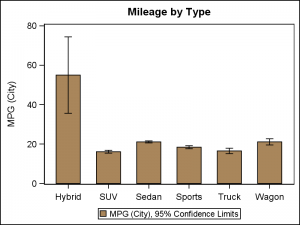 Next, we create a bar chart of mean mileage by type, with display of the 95% confidence limits. A legend is automatically created by the procedure to display the two items in the graph. Also note, I have used GRAPHDATA4 for the bar attributes, and removed the display of the baseline to clean up the display.
Next, we create a bar chart of mean mileage by type, with display of the 95% confidence limits. A legend is automatically created by the procedure to display the two items in the graph. Also note, I have used GRAPHDATA4 for the bar attributes, and removed the display of the baseline to clean up the display.
title 'Mileage by Type';
proc sgplot data=sashelp.cars;
vbar type / response=mpg_city stat=mean
barwidth=0.6
fillattrs=graphdata4 limits=both
baselineattrs=(thickness=0);
xaxis display=(nolabel);
run;
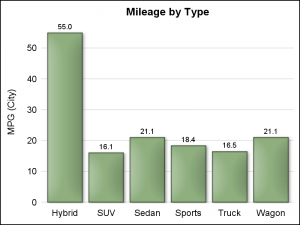 The graph on the right shows the mean mileage by type, using options to create a different look and feel. We have also displayed the response value for each bar at the top. A decorative skin is used to make the bars aesthetically pleasing using DATASKIN=matte.
The graph on the right shows the mean mileage by type, using options to create a different look and feel. We have also displayed the response value for each bar at the top. A decorative skin is used to make the bars aesthetically pleasing using DATASKIN=matte.
In this graph I have suppressed the border around the data area. The axis lines and ticks are removed and y-axis grids are added. This results in a clean graph as shown on the right. Click on the graph for a higher resolution image.
title 'Mileage by Type';
proc sgplot data=sashelp.cars noborder;
format mpg_city 4.1;
vbar type / response=mpg_city stat=mean
datalabel dataskin=matte
baselineattrs=(thickness=0)
fillattrs=(color=&softgreen);
xaxis display=(nolabel noline noticks);
yaxis display=(noline noticks) grid;
run;
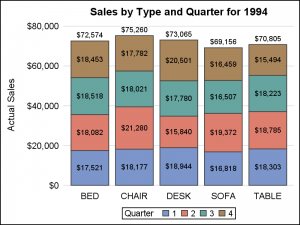 Now, let us add a group classifier using the GROUP=variable option. The SGPLOT procedure summarizes the response data by category and group. Values for each group are stacked for each category, creating a stacked bar chart as shown on the right.
Now, let us add a group classifier using the GROUP=variable option. The SGPLOT procedure summarizes the response data by category and group. Values for each group are stacked for each category, creating a stacked bar chart as shown on the right.
title 'Sales by Type and Quarter for 1994';
proc sgplot data=sashelp.prdsale(where=(year=1994)) noborder;
format actual dollar8.0;
vbar product / response=actual stat=sum
group=quarter seglabel datalabel
baselineattrs=(thickness=0)
outlineattrs=(color=cx3f3f3f);
xaxis display=(nolabel noline noticks);
yaxis display=(noline noticks) grid;
run;
A stacked bar chart makes sense with STAT=SUM (default). Now the bar height is the sum of all the observations for the category. By default, SGPLOT stacks the segments for each group in a category. Note, with SAS 9.4, the segments can be labeled with the value of each segment, and the bar itself can also be labeled with the total value for each bar. Note, a legend showing the color used for each unique value of the group variable is shown.
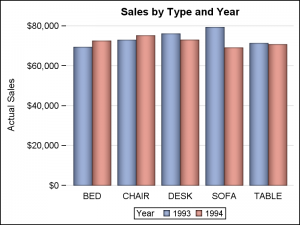 Another useful graph is shown on the right. Here, we have used GROUPDISPLAY=CLUSTER which places the groups side-by-side within each category. A group legend is displayed by default.
Another useful graph is shown on the right. Here, we have used GROUPDISPLAY=CLUSTER which places the groups side-by-side within each category. A group legend is displayed by default.
title 'Sales by Type and Year';
proc sgplot data=sashelp.prdsale noborder;
vbar product / response=actual
group=year groupdisplay=cluster
dataskin=pressed
baselineattrs=(thickness=0);
xaxis display=(nolabel noline noticks);
yaxis display=(noline) grid;
run;
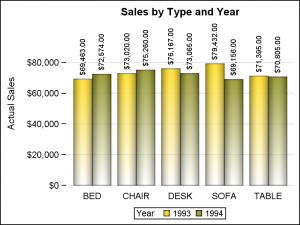 Bar values can be shown for each group in a category, as shown on the right. Note, the values are automatically rotated to a vertical orientation when the values will not fit in the space available.
Bar values can be shown for each group in a category, as shown on the right. Note, the values are automatically rotated to a vertical orientation when the values will not fit in the space available.
Note the use of the STYLEATTRS statement to set the fill colors for the two group values to gold and olive. This statement allows to control the attributes for the group values for fill colors, contrast colors, marker symbols and line patterns. Also, note the use of FILLTYPE=Gradient to color the bars in an alpha gradient, from fully saturated at the top, to transparent at the bottom.
title 'Sales by Type and Year';
proc sgplot data=sashelp.prdsale noborder;
styleattrs datacolors=(gold olive);
vbar product / response=actual
group=year groupdisplay=cluster
dataskin=pressed baselineattrs=(thickness=0)
filltype=gradient datalabel;
xaxis display=(nolabel noline noticks);
yaxis display=(noline) grid;
run;
You may have noted that the VBAR statement supports only one GROUP role, which can then be displayed as STACKED or CLUSTERED. SGPLOT does not support a bar chart that has both a CLUSTER and a STACK group like the SAS/GRAPH GCHART statement. Creating such a graph requires some complex layout of the category axis, and a decision was made to avoid such complex axis layouts as this combination is relatively rare.
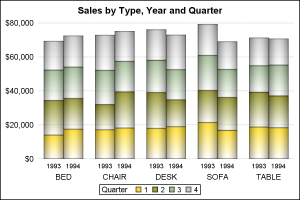 But, what to do if you do need a stacked + clustered bar chart? The solution is to use the SGPANEL procedure as shown below. The resulting graph is shown on the right. Here we have a bar chart of actual sales by type, year and quarter. The year values are side-by-side and the quarter values are stacked.
But, what to do if you do need a stacked + clustered bar chart? The solution is to use the SGPANEL procedure as shown below. The resulting graph is shown on the right. Here we have a bar chart of actual sales by type, year and quarter. The year values are side-by-side and the quarter values are stacked.
The SGPANEL procedure below uses the panel variable of product. So, each "cluster" is really a cell in the panel. Each cell contains a stacked bar chart with category of year and group=quarter. Normally, the cell header is at the top of each cell, with a header border. Here, we have moved the header to the bottom of the graph, and suppressed the cell borders, thus making the graph appear like a stacked+clustered bar chart. Note use of COLAXIS instead of XAXIS and ROWAXIS instead of YAXIS.
title 'Sales by Type, Year and Quarter';
proc sgpanel data=sashelp.prdsale;
styleattrs datacolors=(gold olive &softgreen silver);
panelby product / onepanel rows=1 noborder layout=columnlattice
noheaderborder novarname colheaderpos=bottom;
vbar year / response=actual stat=sum group=quarter barwidth=1
dataskin=pressed baselineattrs=(thickness=0) filltype=gradient;
colaxis display=(nolabel noline noticks) valueattrs=(size=7);
rowaxis display=(noline nolabel noticks) grid;
run;
For all the examples above, the data contains one or more classifier variables with one response variable. This is what is sometimes referred to as a "Tall" structure. But often, the data structure is "Wide", like in an Excel table, with multiple response columns by category.
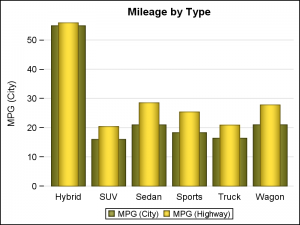 In such a case, it is possible to create a clustered bar chart without transforming the data, by layering the data for each column as shown on the right. Here, we have layered two bar VBAR statements, one for mpg_city and one for mpg_highway, both for the same category variable. Normally, the second layers would cover the first, but we have made the 2nd layer bars narrower, so we can see both.
In such a case, it is possible to create a clustered bar chart without transforming the data, by layering the data for each column as shown on the right. Here, we have layered two bar VBAR statements, one for mpg_city and one for mpg_highway, both for the same category variable. Normally, the second layers would cover the first, but we have made the 2nd layer bars narrower, so we can see both.
title 'Mileage by Type';
proc sgplot data=sashelp.cars noborder;
styleattrs datacolors=(olive gold);
vbar type / response=mpg_city stat=mean
dataskin=pressed baselineattrs=(thickness=0) ;
vbar type / response=mpg_highway stat=mean
dataskin=pressed baselineattrs=(thickness=0)
barwidth=0.5;
xaxis display=(nolabel noline noticks);
yaxis display=(noline) grid;
run;
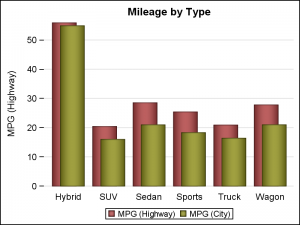 Finally, the bars need not be overlayed on category centers, but can be "offset" to be side-by-side, or even a bit overlapped as shown on the right. Here the bar widths are 0.6, and each VBAR is offset to left or right by 0.1, creating overlapping bars.
Finally, the bars need not be overlayed on category centers, but can be "offset" to be side-by-side, or even a bit overlapped as shown on the right. Here the bar widths are 0.6, and each VBAR is offset to left or right by 0.1, creating overlapping bars.
title 'Mileage by Type';
proc sgplot data=sashelp.cars noborder;
styleattrs datacolors=(brown olive);
vbar type / response=mpg_highway stat=mean
dataskin=pressed barwidth=0.6
baselineattrs=(thickness=0)
discreteoffset=-0.1;
vbar type / response=mpg_city stat=mean
dataskin=pressed barwidth=0.6
baselineattrs=(thickness=0)
discreteoffset= 0.1;
xaxis display=(nolabel noline noticks);
yaxis display=(noline) grid;
run;
There is one restrictioin when layering multiple VBAR statements. The category variables for all VBAR statements must be the same. If a group is specified, it must be specified for all the VBAR statements in the same way. If this is not the case, the program will stop with an error message in the log. There are other ways to handle such cases that will be discussed later.
These examples give you an idea of the versatility of the SGPLOT VBAR statement. You can create bar charts from the simplest to complex and with different aesthetic appearance. I would encourage you to see other examples in this blog on creating bar charts with SGPLOT procedure.
Full code: getting_started_2_vbar






14 Comments
wants to learn the syntax
Pingback: Mixing plots with different classification - Graphically Speaking
Hi, I ran these on SAS 9.4 Linux with EG 5 and got this warning on noheaderborder.
it also didn't like the &softgreen or just softgreen. Is this just a version problem?
noheaderborder novarname colheaderpos=bottom;
______________
1
WARNING 1-322: Assuming the symbol NOHEADER was misspelled as noheaderborder.
&SoftGreen is just a macro variable. Make sure it is assigned. Or, set some other color.
If some options are not supported, you have an older release. Just remove the offending options.
Pingback: Getting started with SGPLOT - Index - Graphically Speaking
I can get data labels under the graph, or in the middle of the bar.
How, though, would I get them at the bottom of the bar, on top of the colored portion?
Our Creative Services designers want it that way, even though I set up a really good SAS-generated vertical bar graph.
One way would be to overlay the data label on the bar using the TEXT plot.
Hello Sanjay,
Could you please tell me how we could insert custom refline between two points? For example
i have x-axis with values 'No Change' '0' '2' '4' '6' '8' '10' '12'. I want draw vertical dotted line between 'No Change' and '0' on x-axis.
For reference example, i have url https://pi.amgen.com/~/media/amgen/repositorysites/pi-amgen-com/aimovig/aimovig_pi_hcp_english.ashx. Please Figure 2 on Page 9.
Thank you,
Sitarama
Hello Sanjay,
Could you please tell me how we could insert custom refline between two points? For example
i have x-axis with values 'No Change' '0' '2' '4' '6' '8' '10' '12'. I want draw vertical dotted line between 'No Change' and '0' on x-axis.
For reference example, i have url https://pi.amgen.com/~/media/amgen/repositorysites/pi-amgen-com/aimovig/aimovig_pi_hcp_english.ashx. Please see Figure 2 on Page 9.
Thank you,
Sitarama
To place a reference line between two discrete tick values, use the DISCRETEOFFSET option. The value for this option can be from -0.5 to +0.5, which places the line at half way to the previous or next tick value. Tick value has to be provided as the formatted text value on the axis
My brother suggested I may like this website.
He was entirely right. This submit actually made my day.
You cann't believe just how much time I had spent for this information! Thank you!
Hello Sanjay,
I am creating stacked vbar char using proc sgplot and one of my value is small. and it doesnt show up on the stacked bar. how do i handle this situation,
here is the code:
```
data sold;
input city $ Sales Type$;
datalines;
current 20 customer
previos 12 manufact
previos 7 customer
previos 0.04 employer
;
run;
proc sgplot data=sold noborder;
styleattrs datacolors = ('#33ccff' '#ff9900' '#bfbfbf');
vbar city / response = sales group = type seglabel groupdisplay=stack barwidth=0.4
grouporder=data baselineattrs=(thickness=0);
x axis discreteorder = data;
xaxis display = (noline nolabel noticks novalues);
yaxis values = (0 to 20 by 2) display = (noline nolabel noticks novalues);
keylegend "mybar"/title="";
format sales dollar8.;
run.
Thanks,
Mahesh
````
It all good - but if you can show how to add a p-value on these graphs would be awesome!
You should be able to do that using the INSET statement.